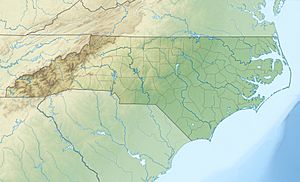Cane River (North Carolina) facts for kids
Quick facts for kids Cane River |
|
|---|---|
|
Location of the mouth of Cane River in North Carolina
|
|
| Country | United States |
| State | North Carolina |
| County | Yancey |
| Physical characteristics | |
| Main source | Confluence of Beech Nursery Creek and Blue Sea Creek Eskota, North Carolina 3,533 ft (1,077 m) 35°45′55″N 82°18′33″W / 35.76528°N 82.30917°W |
| River mouth | Nolichucky River Huntdale, North Carolina 2,024 ft (617 m) 36°01′43″N 82°19′36″W / 36.02861°N 82.32667°W |
| Length | 38.3 mi (61.6 km) |
| Basin features | |
| Progression | Cane → Nolichucky → French Broad → Tennessee → Ohio → Mississippi → Gulf of Mexico |
| River system | French Broad River |
| Basin size | 408.79 square miles (1,058.8 km2) |
The Cane River is a beautiful river in Yancey County, North Carolina. It flows for about 38.3 miles (61.6 km). This river starts where two creeks meet: Beech Nursery Creek and Blue Sea Creek. These creeks come from the Black Mountains. The Cane River is part of a larger river system. It flows north and joins the North Toe River. Together, they form the Nolichucky River. The Cane River is an important tributary (a smaller river flowing into a larger one) in the French Broad River basin.
The Story of Cane River Dam
The Cane River once had a dam called the Cane River Dam. It was built in 1908 to make electricity for Yancey County. The dam was made of strong concrete. It stood 45 feet (14 m) tall and was 245 feet (75 m) wide.
Over the years, the dam faced challenges. In 1940, a big flood covered its powerhouse. By the 1950s, the dam's structure was getting weaker. Another large flood in the 1970s caused part of the dam to break.
Starting in 2008, groups like the Blue Ridge Resource Conservation and Development worked to remove the dam. They teamed up with the U.S. Fish & Wildlife Service and the North Carolina Wildlife Resources Commission. Their goal was to help the river return to its natural state. The project finished in October 2016. Now, the Cane River flows freely without the dam.
Keeping the River Clean
Rivers are important for nature and people. The Cane River has faced some challenges with its health. In the past, digging for gravel in the river changed its natural shape. This made parts of the river look different from how they should.
In 2004, some smaller streams flowing into the Cane River had high levels of certain bacteria. Later, in 2008, a local water treatment plant had a problem. This caused more bacteria to spill into the river. This spill was harmful to wildlife living downstream, including a special type of mussel called the Appalachian elktoe.
Since then, improvements have been made to the wastewater plant. However, after heavy rains, the Yancey County Health Department sometimes warns people to be careful. This is to make sure everyone stays safe and the river stays as clean as possible. Protecting our rivers helps all the plants and animals that call them home.


